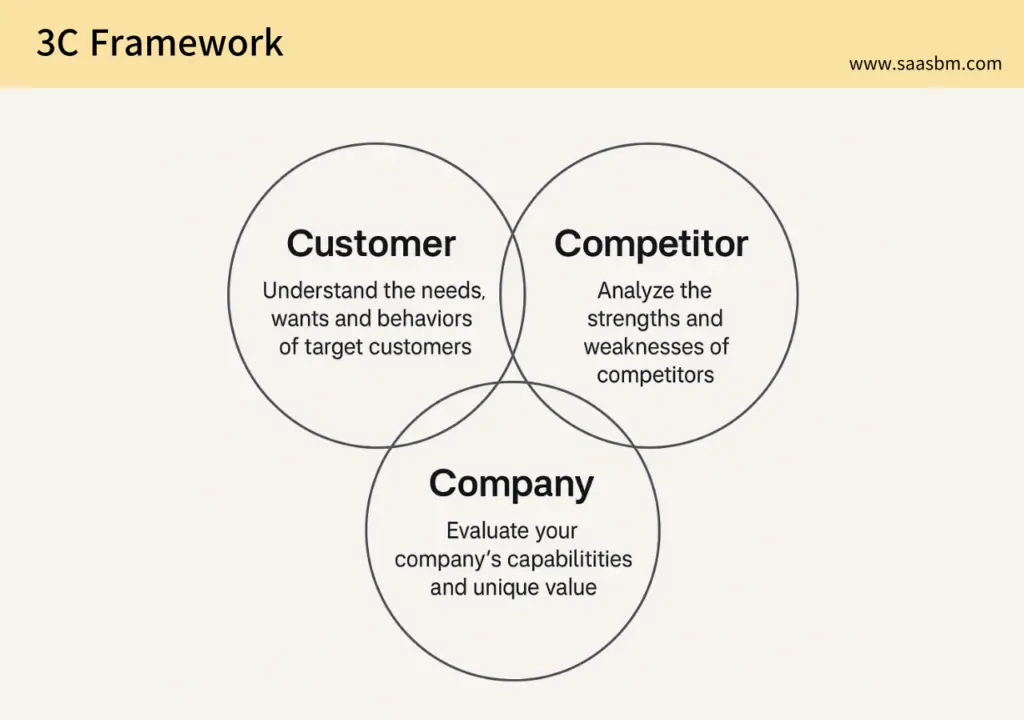Introduction
Launching a SaaS startup isn’t just about writing great code or releasing cool features.
It’s about building something that your customers truly need—something that stands out in a crowded market and plays to your unique strengths.
To do that, you need a clear strategic lens.
That’s where the 3C Analysis Framework comes in.
Used by top strategists and product teams, 3C helps you answer three crucial questions:
- Who are your real customers, and what do they want?
- What are your competitors doing, and how can you differentiate?
- What strengths does your company have to win in this market?
Let’s break it down.
What is the 3C Framework?
The 3C Framework was originally introduced by Kenichi Ohmae and has been widely adopted across industries.
For SaaS businesses, it means analyzing the market from three angles:
- Customer – Understand who you’re serving and what they’re trying to accomplish.
- Competitor – Identify your competitors and what makes them successful or vulnerable.
- Company – Pinpoint your strengths, capabilities, and limitations as a team and a business.
Where these three align is where your opportunity lies.
1. Customer: Who Are You Really Serving?
In SaaS, your customer is not just a “user” but someone with a job to be done.
That job might be:
- Functional: Manage tasks, streamline processes, automate workflows
- Emotional: Feel less overwhelmed, be seen as efficient
- Organizational: Improve reporting, meet compliance, reduce team friction
Ask yourself:
- Who is the buyer? Who is the user?
- What pain are they solving today—often with spreadsheets or manual work?
- How urgent is their need? Are they willing to pay?
The better you understand your customer’s world, the better your product-market fit will be.

2. Competitor: Who Else Is Solving the Same Problem?
Competition in SaaS is fierce—and not always obvious.
It includes:
- Direct competitors – Companies offering similar SaaS tools
- Indirect competitors – General-purpose tools (Excel, Notion) or manual solutions
What to evaluate:
- Their product features and strengths
- Their pricing model
- Their brand messaging and customer perception
- What users love or hate based on reviews
Understanding your competitors helps you define your differentiator.
3. Company: What Are You Uniquely Good At?
Not all SaaS teams are the same.
You need to play to your strengths, whether that’s:
- Technical expertise (e.g., NLP, AI, infrastructure)
- Domain knowledge (e.g., legaltech, edtech)
- Access to an initial user base or network
- Speed, agility, or design excellence
Ask:
- What unique insight do we have about the market?
- What can we build faster or better than others?
- Where are we weak—and how do we mitigate that?
SaaS Example: “Docly” – An AI-Powered Contract Generator
| Component | Analysis |
|---|---|
| Customer | Freelancers, small startups, legal teams who want fast and simple contract creation |
| Competitor | PandaDoc, DocuSign, Notion templates |
| Company | Strong NLP capabilities, clean UX, affordable pricing, tailored for small teams |
Insight:
Rather than chasing complex enterprise features, focus on speed, ease-of-use, and affordability. Win early adopters in the freelance and SMB space before expanding vertically.
Summary: A Simple Framework with Strategic Power
| C | Strategic Focus |
|---|---|
| Customer | Who is your ideal user and what problem do they face? |
| Competitor | What alternatives exist and how are you different? |
| Company | What strengths can you uniquely leverage? |
3C isn’t just about research—it’s about building clarity and confidence into your decisions.
Final Thoughts
Startups often rush into building and shipping.
But building without strategic alignment leads to burnout and missed opportunities.
The 3C Framework brings structure to your intuition.
It guides your thinking across market, user, and team.
Before you build your MVP, pitch investors, or launch your next campaign—step back and ask:
- Do we really understand our Customer?
- Do we know how we differ from our Competitors?
- Do we know what we’re uniquely capable of as a Company?
3C is where strategy starts.

No comment yet, add your voice below!